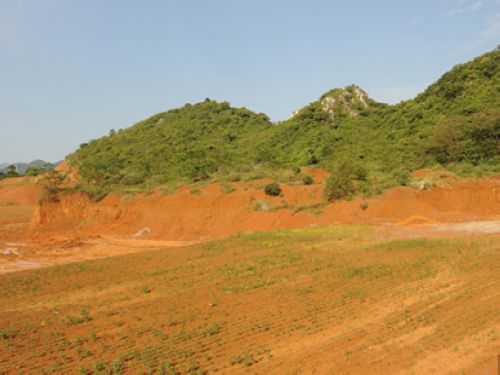 Recently, through the geological survey and evaluation project titled "Geological Survey and Availability of Low-Grade Bauxite in the Dengfeng-Xinmi Area of Henan Province," the Zhengzhou Comprehensive Institute, under the guidance of experts from the Tianjin Geological Survey Center, conducted extensive field investigations in Henan Province. The project focused on areas such as Dengfeng, Xinmi, Ganxian, Baofeng, and Lushan counties, where significant geological reserves of bauxite were identified. These regions show great potential for further exploration. Notably, this type of bauxite was first discovered in North China, marking a major breakthrough in the region’s mineral resources.
The newly identified bauxite deposits are found within Quaternary loose sediments, characterized by brownish-red and gray-purple gravel and detritus. The ore primarily consists of clay-clay bauxite with a small amount of limonite. The bauxite occurs in various sizes, ranging from 0.5 cm to 20 cm, with concentrations typically between 2 cm and 10 cm. The gravel is well-rounded and well-sorted, indicating a long transport history. The ore layer thickness varies from 0.2 m to 5 m. The top of the deposit is usually covered by topsoil or overburden, consisting of yellow-brown humus and clay, which is loose and poorly cemented. The boundaries of the ore body are distinct, and the overlying layers vary in thickness. Some deposits are exposed at the surface, while others are buried beneath thick layers of soil. The base of the deposit is typically limestone or clay rock.
These deposits can be broadly categorized into two types. The first type is found within karst funnels in bedrock areas, where the thickness of the bauxite deposit correlates with the size of the funnel, generally ranging from 0.5 m to 5 m. The second type occurs within the Quaternary laterite (loess) layer, forming a near-horizontal layer with thicknesses between 0.2 m and 3 m.
This type of bauxite has a high grade, with an aluminum-to-silicon ratio exceeding 7, making it easy to process and mine. Additionally, the recovery of bauxite deposits located in farmland could potentially improve soil quality, offering both economic and environmental benefits.
The discovery of these accumulated bauxite deposits in Henan challenges previous assumptions that such deposits were only present in southern China. This finding holds significant implications for future exploration efforts in northern China, opening up new possibilities for resource development in the region.
Recently, through the geological survey and evaluation project titled "Geological Survey and Availability of Low-Grade Bauxite in the Dengfeng-Xinmi Area of Henan Province," the Zhengzhou Comprehensive Institute, under the guidance of experts from the Tianjin Geological Survey Center, conducted extensive field investigations in Henan Province. The project focused on areas such as Dengfeng, Xinmi, Ganxian, Baofeng, and Lushan counties, where significant geological reserves of bauxite were identified. These regions show great potential for further exploration. Notably, this type of bauxite was first discovered in North China, marking a major breakthrough in the region’s mineral resources.
The newly identified bauxite deposits are found within Quaternary loose sediments, characterized by brownish-red and gray-purple gravel and detritus. The ore primarily consists of clay-clay bauxite with a small amount of limonite. The bauxite occurs in various sizes, ranging from 0.5 cm to 20 cm, with concentrations typically between 2 cm and 10 cm. The gravel is well-rounded and well-sorted, indicating a long transport history. The ore layer thickness varies from 0.2 m to 5 m. The top of the deposit is usually covered by topsoil or overburden, consisting of yellow-brown humus and clay, which is loose and poorly cemented. The boundaries of the ore body are distinct, and the overlying layers vary in thickness. Some deposits are exposed at the surface, while others are buried beneath thick layers of soil. The base of the deposit is typically limestone or clay rock.
These deposits can be broadly categorized into two types. The first type is found within karst funnels in bedrock areas, where the thickness of the bauxite deposit correlates with the size of the funnel, generally ranging from 0.5 m to 5 m. The second type occurs within the Quaternary laterite (loess) layer, forming a near-horizontal layer with thicknesses between 0.2 m and 3 m.
This type of bauxite has a high grade, with an aluminum-to-silicon ratio exceeding 7, making it easy to process and mine. Additionally, the recovery of bauxite deposits located in farmland could potentially improve soil quality, offering both economic and environmental benefits.
The discovery of these accumulated bauxite deposits in Henan challenges previous assumptions that such deposits were only present in southern China. This finding holds significant implications for future exploration efforts in northern China, opening up new possibilities for resource development in the region.lsb board is a new generation of environmentally friendly home board, is an innovative technology and environmentally friendly high-energy home board. lsb board is the upgraded version of OSB BOARD, is a solid wood slicing board.
LSB BOARD,LSB PLYWOOD,LSB CHIPBOARD, Osb3 European Pine Plate,12mm Thick European Pine Board
Linyi Lanshan Weipu Rubber Factory , https://www.weipuwood.com